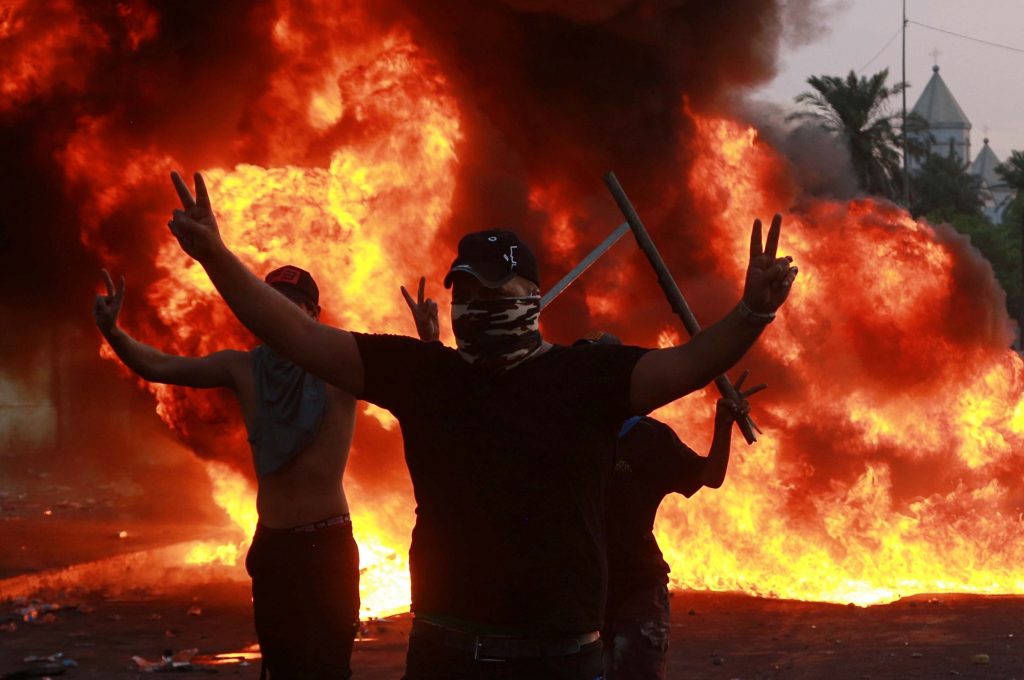Baghdad: Anti-government demonstrators defied an around-the-clock curfew in Baghdad and other cities Thursday as Iraqi security forces used live ammunition and tear gas during a third day of unrest that has left 31 people dead, most of them protesters.
Authorities cut internet access in much of Iraq since late Wednesday in a desperate move to curb the rallies. By Thursday afternoon, the curfew was extended to three other southern provinces.
The spontaneous rallies have been spurred mostly by youths wanting jobs, improved services such as electricity and water, and an end to endemic corruption in the oil-rich country. Most of the demonstrators were peaceful; many had their faces covered with masks or Iraqi flags.
The streets here were littered with tear gas canisters and empty bullet casings. Smoke from burned tyres rose above the streets as protesters tried to prevent security forces from advancing. The forces spread barbed wires and armoured vehicles to block their path.
“Even with a curfew, we are not turning back,” shouted protester Abu Qassim.
The unrest is the most serious challenge for Prime Minister Adel Abdul-Mahdi’s year-old government, which also has been caught in the middle of increasing US-Iran tensions in the region.
Iraq is allied with both countries and hosts thousands of US troops, as well as powerful paramilitary forces allied with Iran.
Middle East expert Jennifer Cafarella, with the Washington-based Institute for the Study of War, said the immediate and widespread use of force against protesters in multiple provinces demonstrates ‘that the security forces are overwhelmed by the volume and rate of spread’ of the rallies.
There were indications that the regional tension is at play. Some Baghdad demonstrators blamed Iranian-backed groups within the security forces for the violence. Media affiliated with the Iranian-backed groups have pointed fingers at the United States and Saudi Arabia for the unrest.
One protester in Baghdad held up an empty casing to journalists, screaming: “Look! These are Iranian bullets!” In the last three days, at least 20 protesters and one policeman were killed in four provinces. On Thursday, the first death was reported here where one protester was killed as the demonstrators pushed their way toward Tahrir Square in the city centre.
The square has been off-limits since Wednesday night just before the curfew. Soon after, protesters overpowered a soldier in his armoured vehicle, setting it on fire and warning other security forces to stay away from the square. The protesters then marched toward the square. There were also fires set to parts of government buildings in the southern provinces of Najaf and Dhiqar.
At least three protesters were shot and killed Thursday in Zaafaraniya, a southern Baghdad neighborhood, according to police and a medial official.
In another development, at least six protesters were shot and killed Thursday in the city of Nasiriyah, about 320 kilometers (200 miles) south of Baghdad, a medical official told reporters. Nasiriyah has seen the most violence since the protests began Tuesday.
The leaderless protests have been concentrated here and in predominantly Shiite areas of southern Iraq, bringing out jobless youths and university graduates who are suffering under an economy reeling from graft and mismanagement.
“I came here to seize back my rights,” said Ahmed Abdul-Sattar, a protester in his early 20s. “I can’t get a government job or find any other job. It is a corrupt government and we came here to take our rights,” he death.
Other than the deaths reported Thursday, there were at least 17 people killed Wednesday including a policeman, in rallies in Nasiriyah, Kut, and Amara, according to security officials.
AP
